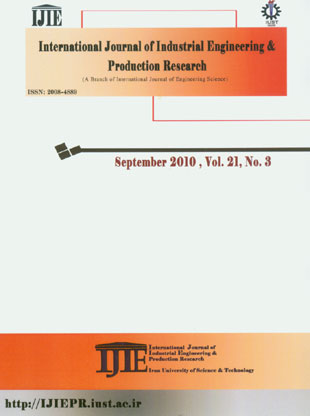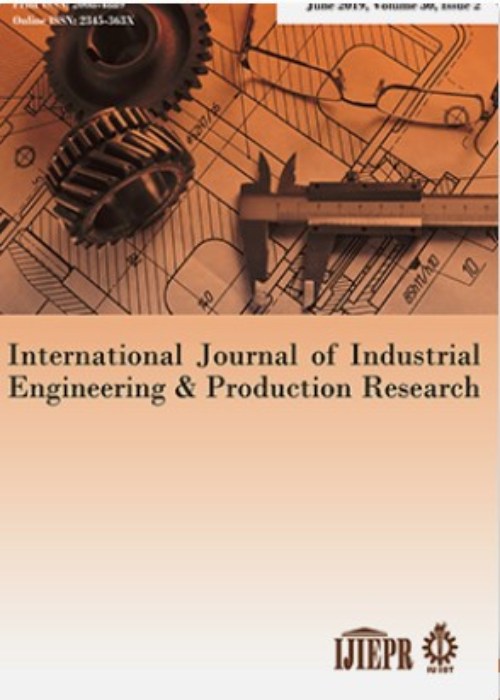فهرست مطالب

International Journal of Industrial Engineering and Productional Research
Volume:21 Issue: 3, sep 2010
- تاریخ انتشار: 1389/10/11
- تعداد عناوین: 7
-
-
Page 111In the classical versions of “Best Choice Problem”, the sequence of offers is a random sample from a single known distribution. We present an extension of this problem in which the sequential offers are random variables but from multiple independent distributions. Each distribution function represents a class of investment or offers. Offers appear without any specified order. The objective is to accept the best offer. After observing each offer, the decision maker has to accept or reject it. The rejected offers cannot be recalled again. In this paper, we consider both cases of known and unknown parameters of the distribution function of the class of next offer. Two optimality criteria are considered, maximizing the expected value of the accepted offer or the probability of obtaining the best offer. We develop stochastic dynamic programming models for several possible problems, depending on the assumptions. A monotone case optimal policy for both criteria is proved. We also show that the optimal policy of a mixed sequence is similar to the one in which offers are from a single density.
-
Page 121In this paper an Ant Colony (ACO) algorithm is developed to solve aircraft recovery while considering disrupted passengers as part of objective function cost. By defining the recovery scope, the solution always guarantees a return to the original aircraft schedule as soon as possible which means least changes to the initial schedule and ensures that all downline affects of the disruption are reflected. Defining visibility function based on both current and future disruptions is one of our contributions in ACO which aims to recover current disruptions in a way that cause less consequent disruptions. Using a real data set, the computational results indicate that the ACO can be successfully used to solve the airline recovery problem.
-
Page 129Steel market and particularly rod bar market play important roles in economy of countries. Economic systems are considered as complex systems which are sophisticated to be modeled mathematically. One way to model these systems is simulation and use of system dynamics. This paper models rod bar supply chain in Iran using system dynamics. Data of this research is gathered from first hand materials published by governmental sector. In order to modeling relationships between variables, interviews were conducted with experts in Iran Ministry of Commerce. Proposed model explains turbulence of rod bar market during 5 years ago and the fluctuations of its price. In addition, it is examined and confirmed by experts of this market in Iran Ministry of Commerce. Although proposed model may not offer an exact prediction of future market, but could be used as an applicable tool for analyzing and adjusting the market in Iran Ministry of Commerce.
-
Page 137One of the most famous methods for recommendation is user-based Collaborative Filtering (CF). This system compares active user’s items rating with historical rating records of other users to find similar users and recommending items which seems interesting to these similar users and have not been rated by the active user. As a way of computing recommendations, the ultimate goal of the user-based collaborative filtering is recommending items with the high accuracy and coverage degree. Nevertheless, some famous limitations are obstacles to meet them. They are Scalability, Sparseness and new item problems. Scalability problem can be handled with the use of Data Mining techniques like clustering. However, use of this technique often leads to the lower recommendation accuracy. Nevertheless, two other problems still remain. Involving Semantic knowledge can increase the performance of recommendation in sparseness and New-Item Problem conditions as well. This paper presents a new approach to deal with the drawbacks of user-based CF systems for web pages recommendation by Combination of Semantic Knowledge with Web Usage Mining (WUM). Semantic knowledge of web pages are extracted and subsequently incorporated into the navigation patterns of each cluster which obtained from clustering the access sessions to get the Semantic Patterns of each cluster. The cluster with the most relevant semantic pattern is chosen with the comparison of semantic representation of the active user session with the semantic patterns and the proper web pages are recommended based on a switching recommendation engine. This engine recommends a list of appropriate recommendations. Results of the implementation of this hybrid web recommender system indicates that this combined approach yields better results in both accuracy and coverage metrics and also has a considerable capability to handle collaborative filtering recommender system for its typical shortcomings.
-
Page 147This paper proposes two relax and fix heuristics for the simultaneous lot sizing and sequencing problem in permutation flow shops involving sequence-dependent setups and capacity constraints. To evaluate the effectiveness of mentioned heuristics, two lower bounds are developed and compared against the optimal solution. The results of heuristics are compared with the selected lower bound.
-
Page 155One of an important factor in the success of organizations is the efficiency of knowledge flow. The knowledge flow is a comprehensive concept and in recent studies of organizational analysis broadly considered in the areas of strategic management, organizational analysis and economics. In this paper, we consider knowledge flows from an Information Technology (IT) viewpoint. We usually have two sets of technological challenges that prevent the knowledge flow efficiency in the organizations: the passive kind of present knowledge management technologies and the information excess problem. To get the efficient flow of knowledge, we need high exactness recommender systems and dynamic knowledge management technologies that automate knowledge transportation and permit the management and control of knowledge flow. In this paper, we combine and make upon the information management systems and workflows presented in literature to generate technologies that address the serious gap between current knowledge management systems. Also, we propose a knowledge management framework for educational organizations and use this framework in a real situation and analyze the results. The weakness of knowledge flow infrastructure is one of the most important barriers to knowledge sharing through an organization. The proposed technology in this paper provides a new generation of knowledge management systems that will permit the efficient flow of knowledge and conquest to the technological constraints in knowledge sharing across an organization.
-
Page 163Omni directional mobile robots have been popularly employed in several applications especially in soccer player robots considered in Robocup competitions. However, Omni directional navigation system, Omni-vision system and solenoid kicking mechanism in such mobile robots have not ever been combined. This situation brings the idea of a robot with no head direction into existence, a comprehensive Omni directional mobile robot. Such a robot can respond more quickly and it would be capable for more sophisticated behaviors with multi-sensor data fusion algorithm for global localization base on the data fusion. This paper has tried to focus on the research improvements in the mechanical, electrical and software design of the robots of team ADRO Iran. The main improvements are the world model, the new strategy framework, mechanical structure, Omni-vision sensor for object detection, robot path planning, active ball handling mechanism and the new kicker design,, and other subjects related to mobile robot.


